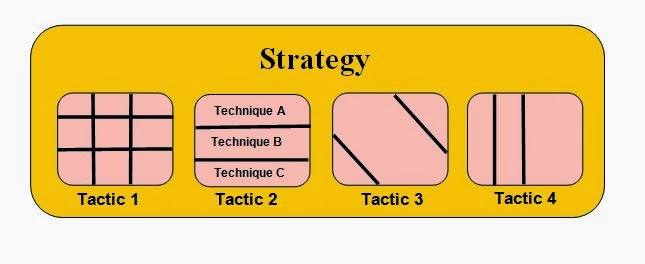Why effective Techniques and Tactics don’t necessarily create effective Strategies.
There are basic TACTICS that people use in response to confrontation and conflict. These responses are the sum of (1) their instinctive behaviors, (2) behaviors that are learned and conditioned from being a member of society, and (3) behaviors that are learned and conditioned from specific training.
When these Tactics are combined, they form an overall STRATEGY.
The effectiveness of a Tactic may be separate from the result of the Strategy. The effectiveness of a Strategy must take into consideration the consequences and chances of failure (risk) and depends upon the context of the situation.
A Strategy that works almost all of the time, but is subject to catastrophic failure may not be as effective as a Strategy that works the majority of the time, but the failures are of much less consequence.
For example, running across a busy street is an effective Tactic for getting to the other side. It is quicker and more direct than going to a foot bridge or crosswalk. But as an ongoing Strategy, it is not effective due to the high negative consequences of being struck by a car.
On the other hand, if you are being chased by a serial killer, you most likely will choose the running across Tactic over searching for a pedestrian crossing Tactic. The rational is that the risk of being caught by the serial killer out weighs the risk of being struck by a car.
Thus, the Running Strategy for escape is more effective than the Cross-walk Strategy. Therefore, effective Tactics don’t necessarily make for effective Strategies and vice-versa. It all depends upon the context of the situation. Successive Tactics form the building blocks of a complex Strategy.
TECHNIQUES are the steps that create the Tactics. In the prior example. The technique of darting across the street in a manner that allows for high visibility and quick directional changes is more effective than a head down flat out sprint. Darting is a technique that could be instinctual, or it could be environmentally learned or formally trained.
To summarize: Techniques make up Tactics which make up Strategies. The effectiveness of a Strategy is both dependent and independent of the effectiveness of the underlying Tactics and Techniques. Generally speaking, ineffective Techniques will lead to ineffective Tactics which create ineffective Strategies. But effective Techniques and Tactics don’t necessarily create an effective Strategy if the associated risk is too high. The associated risk depends upon the context of the situation.
Multiple Techniques + Technical Context create Tactics
Multiple Tactics + Tactical Context create Simple Strategies
Multiple Simple Strategies + Strategic Context create Comprehensive Strategies
Conclusion: Your well trained knockout punch Technique may build a poor self-defense Strategy. Your Tactic of brandishing a deadly weapon may also diminish your self-defense Strategy in certain situations. Your habit of submitting to confrontations may inhibit your self-defense Strategy.
On the other hand, your Tactic of quickly Mitigating mistakes and transitioning to different Tactics may dramatically increase the overall effectiveness of your self-defense Strategy. It all depends upon the context of the situation.
—————————-
1. This is a DECIDE stage in terms of the 5D’s of Self-Defense – DECIDE– DETER-DISRUPT-DISENGAGE-DEBRIEF
It deals with education and training before an event.
